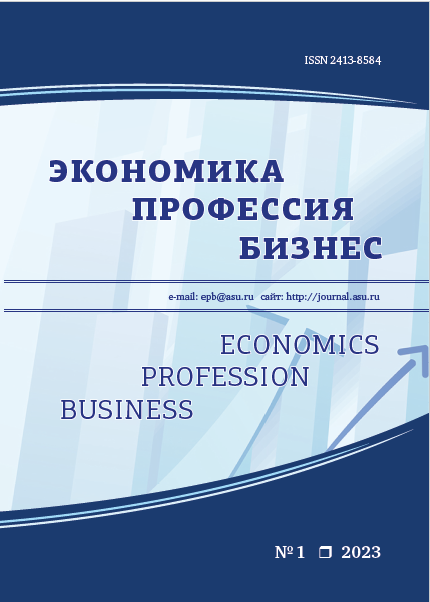INNOVATIVE AND INVESTMENT ACTIVITIES OF DOMESTIC ENGINEERING: STATUS AND TRENDS
УДК 338.45
Abstract
In today’s reality, Russia’s technological vulnerability problem requires an urgent solution. Therefore, intensifying investment and innovation activities in the mechanical engineering sector, the main system-forming sector of the economy, is crucial for the survival of our country. The author recognizes the close interdependence of investment and innovation processes and aims to conduct a comparative and correlation analysis based on official data from the Federal State Statistics Service for one type of activity related to mechanical engineering.
The study reveals that the crisis in Russian engineering, which began in the 1990s, is ongoing, with extremely low levels of innovation and investment. These factors are insufficient for the technical and technological re-equipment of the country’s machine-building sector. Additionally, the depreciation of partially and completely worn-out equipment exacerbates the crisis.
The author believes that the development of mechanical engineering and related sectors in the Russian economy can only occur when the ruling elites implement a radical change in the direction of state policy. This change should prioritize the integrated use of state support measures to systematically address the identified problem. The author emphasizes that such a change in policy should follow a rhetoric of innovation and investment by the ruling elites.
Downloads
Metrics
References
ОК 029-2014 (КДЕС Ред. 2). Общероссийский классификатор видов экономической деятельности (утв. Приказом Росстандарта от 31.01.2014 № 14-ст) (ред. от 23.12.2021). URL: http://www.consultant.ru/document/cons_doc_LAW_163320/ (дата обращения: 31.05.2022).
Промышленное производство в России // Официальный сайт Федеральной службы государственной статистики РФ. URL: https://rosstat.gov.ru/folder/210/document/13225 (дата обращения: 02.06.2022).
Российский статистический ежегодник — 2003, 2011, 2021. Официальный сайт Федеральной службы государственной статистики. URL: https://rosstat.gov.ru/folder/210/document/12994 (дата обращения: 13.09.2022).
Асканова О. В. Машиностроение России: статистический обзор // Современная техника и технологии: проблемы, состояние и перспективы: материалы Десятой всероссийской научно-практической конференции. Рубцовск, 2020. С. 240-248.
Стрельцов А. В., Яковлев Г. И. Оценка потенциала развития машиностроительного комплекса в условиях цифровой экономики // Вестник Алтайской академии экономики и права. 2020. № 8 (часть 2). С. 301-308.
Борисов В. Н., Почукаева О. В. Инновационно-насыщенные инвестиции в машиностроении: внешнеэкономические эффекты // Научные труды: Институт народнохозяйственного прогнозирования РАН. М., 2020. С. 380-394.
Гусев С. А., Жариков В. Д. Модернизация российской экономики на основе развития машиностроения // Вестник МФЮА. 2018. № 2. С. 87-97.
Ибрагимов М. Р. Анализ состояния инновационной деятельности российского машиностроения // Вестник Самарского государственного университета. Серия: Экономика и управление. 2011. № 10 (91). С. 41-47.
Абрашкин М. С. Наукоемкость и инновационное развитие предприятий машиностроения // Вестник АГТУ. Серия: Экономика. 2018. № 4. С. 107-115.
Асканова О. В. Как превратить сельхозмашиностроение в передовой сектор экономики // ЭКО. 2017. № 12 (522). С. 60-70.
REFERENCES
OK 029-2014 (NACE Rev. 2). All-Russian classifier of types of economic activity (approved by Order of Rosstandart dated January 31, 2014 No. 14-st) (as amended on December 23, 2021). URL: http://www.consultant.ru/document/cons_doc_LAW_163320/ (date of access: 31.05.2022).
Industrial production in Russia. // Official site of the Federal State Statistics Service of the Russian Federation. URL: https://rosstat.gov.ru/folder/210/document/13225 (date of access: 02.06.2022).
Russian Statistical Yearbook — 2003, 2011, 2021. Official website of the Federal State Statistics Service. URL: https://rosstat.gov.ru/folder/210/document/12994 (date of access: 13.09.2022).
Askanova O. V. Mechanical engineering in Russia: a statistical review // Modern technics and techology: problems, state and prospects: materials of the Tenth all-Russian scientific and practical conference. Rubtsovsk, 2020. Pp. 240-248.
Streltsov A. V., Yakovlev G. I. Assessment of the machine-building complex development potential in the digital economy // Bulletin of the Altai Academy of Economics and Law. 2020. No. 8 (part 2). Pp. 301-308.
Borisov V. N., Pochukaeva O. V. Intensive investments in mechanical engineering: external economic effects // Scientific works: Institute of Economic Forecasting of the Russian Academy of Sciences. 2020. Pp. 380394.
Gusev S. A., Zharikov V. D. Modernization of the Russian economy based on the development of mechanical engineering // Vestnik MFaLA. 2018. No. 2. Pp. 87-97.
Ibragimov M. R. Analysis of the innovation activity state of Russian mechanical engineering // Bulletin of the Samara State University. Series: Economics and Management. 2011. No. 10 (91). Pp. 41-47.
Abrashkin M. S. Science intensity and innovative development of mechanical engineering enterprises // Bulletin of ASTU. Series: Economy. 2018. No. 4. Pp. 107-115.
Askanova O. V. How to turn agricultural engineering into an advanced sector of economy // EKO. 2017. No. 12 (522). Pp. 60-70.
Copyright (c) 2023 Оксана Владимировна Асканова

This work is licensed under a Creative Commons Attribution 4.0 International License.
Economics Profession Business is a golden publisher, as we allow self-archiving, but most importantly we are fully transparent about your rights.
Authors may present and discuss their findings ahead of publication: at biological or scientific conferences, on preprint servers, in public databases, and in blogs, wikis, tweets, and other informal communication channels.
Economics Profession Business (EPB) allows authors to deposit manuscripts (currently under review or those for intended submission to EPB) in non-commercial, pre-print servers such as ArXiv.
Authors who publish with this journal agree to the following terms:
- Authors retain copyright and grant the journal right of first publication with the work simultaneously licensed under a Creative Commons Attribution License that allows others to share the work with an acknowledgement of the work's authorship and initial publication in this journal.
- Authors are able to enter into separate, additional contractual arrangements for the non-exclusive distribution of the journal's published version of the work (e.g., post it to an institutional repository or publish it in a book), with an acknowledgement of its initial publication in this journal.
- Authors are permitted and encouraged to post their work online (e.g., in institutional repositories or on their website) prior to and during the submission process, as it can lead to productive exchanges, as well as earlier and greater citation of published work (See The Effect of Open Access).









